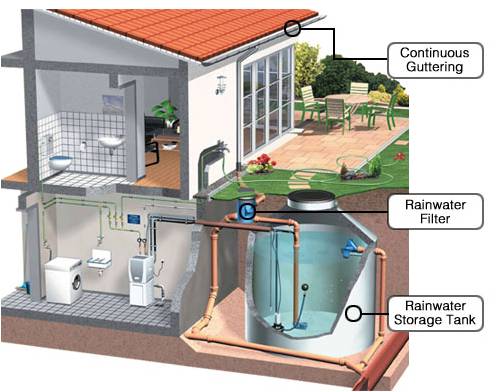 I. Why Rainwater Harvesting?
I. Why Rainwater Harvesting?
Rainwater Harvesting (RWH) is the principle of collecting and using precipitation from catchment surfaces. We carried out a detailed water usage audit in our society, wherein a clear picture emerged on water usage in each segment of the society (For eg. a typical society uses about 30-35% of its total water in flush tanks!) Rainwater storage was into an existing bavdi (well) and underground tanks as required. This collected rainwater is being used for gardening, washing cars, cleaning building floor tiles and at common toilets, saving us in water bills.
Other benefits of Rainwater Harvesting (RWH):
- Due to rapid urbanization, infiltration of rainwater into the sub-soil has decreased drastically. We can help increase the ground water table.
- Rainwater being very pure and soft, it significantly lower the quantity of detergents and soaps needed for cleaning. Also, pipes are free of the deposits caused by hard water and should last longer.
- MCGM supplies 3,250 million liters of water everyday, against a demand of 4,200 million liters per day to the Mumbai city. The residential localities within the MCGM area will be supplied only 90 liters of water per person per day down from 135 lpcd. RWH can make us a little self-sufficient.
II. An amazing amount of water can be collected
According to Texas Natural Resource Conservation Commission, the rule of thumb is 2,300 liters of water per inch of rain per thousand square feet of catchment area. Mumbai receives on an average 1,800 mm of rainfall every year or about 72 inches per annum. But some of the rain will overshoot the gutters or spill out of gutters during heavy downpours. So efficiency is presumed to be 75% to 90% depending on system design and capacity. Our society (Avanti Niketan CHS) catchment area is 40,000 square feet (terraces and paved roads).
The basic formula for calculating the approximate potential amount that can be collected is:
(40,000 sq ft of catchment area x 72 inches of rain x 2300 liters per inch x 0.75 efficiency)/ 1000
= 50,00,000 liters of water collected annually or approximately 12,50,000 liters per monsoon month.
 III. Rainwater Harvesting system components:
III. Rainwater Harvesting system components:
Coarse mesh was used at the roof to prevent the passage of debris like plastic bags and paper pieces, into the down pipes or channels.
Gutter chambers can be made using concrete, galvanized iron sheet or PVC material, with a capacity of 10 to 15 per cent over that required for highest intensity rain flow.
We used conduits or pipelines of materials like PVC (not advisable), galvanized iron (GI) and concrete pipes, to carry rainwater to the rainwater harvesting system.
First flush device is a valve that ensures that runoff from the first spell of rain is flushed out and does not enter the system, as it carries a relatively larger amount of pollutants from the air and catchment surface.
A simple sand filter can be constructed domestically in a drum, with the top layer comprises coarse sand followed by a 5-10 mm layer of gravel followed by another 5-25 cm layer of gravel and pebbles or boulders, to filter pollutants.
Storage can be both underground storage tanks as well re-charge to ground water through an old well. Water quality will improve during storage provided fresh inflows do not stir up any sediment and sunlight and living organisms are excluded from the tank with a wire or nylon mesh. Taps should be atleast five centimeters above the tank floor, depending on debris accumulation rates.
IV. Treatment of stored water
The most common methods are chlorination (a mixture of chlorine and lime), boiling, filtration and exposure to natural sunlight’s ultraviolet rays. About 1 gm of bleaching powder is sufficient to treat 200 litres of water. A few Chlorine tablets of 0.5 gm is enough to disinfect 20 litres (a bucketful) of water.
Following aspects should also be taken care of:
- Just before the arrival of monsoon, the rooftop/ catchment area has to be cleaned properly.
- The filter materials have to be either replaced or washed properly before the monsoon.
- All polluted water should be taken away from the recharge structures.
V. Other methods of re-charge:
Water re-charge can be done through the following mechanisms:
- Trench or shafts or pits may be constructed, which are back filled with boulders, gravels, coarse sand.
- Existing wells or hand pumps or bore wells or ring wells may be utilized as recharge structures. If a new well is to be dug, then BMC permission is required.
- Water can be spread in streams/ nalas by making check dams or a percolation pond
VI. Cost
Rainwater harvesting methods are site specific and hence it is difficult to give a generalized cost. A good proportion of the expenses would be for the storage tanks and pipe connections. By judiciously fixing up the slopes of roofs and location of rainwater outlets, this could be brought down considerably. Since we already had an existing underground tank, our total cost was a little over Rs 200,000, and expected return on investment is 3 years.
For help from MCGM to implement RWH, please contact:
Rain Water Harvesting Cell
Municipal Head Office, Mahapalika Marg, Mumbai 400 001
Tel. 22691001, 22620251 ext. 2309
